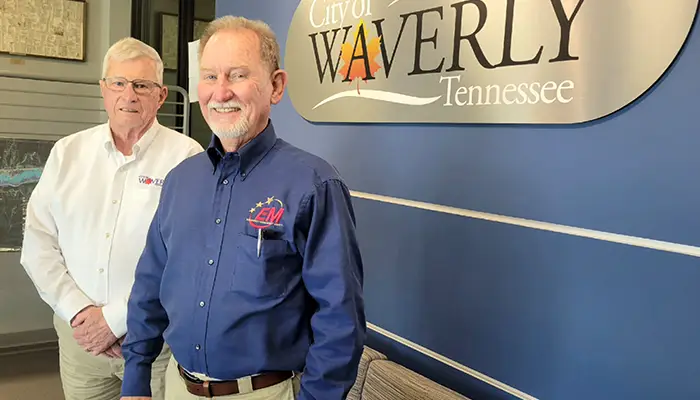IN THE FIELD: WAVERLY’S FAITHFUL PUBLIC SERVANTS
Communications specialist

WAVERLY — W.B. “Buddy” Frazier and Odell Poyner don’t hunt, fish, or golf.
“And if you don’t do one of those three things in our county, there’s not a lot of hobbies for you, is there?” said Frazier with a chuckle.
Instead, these two men have dedicated their lives to serving the town of Waverly: Frazier as mayor for the past decade and Poyner as Humphreys County Emergency Management Agency director. Their commitment has been tested repeatedly by historic disasters that have shaped both the town and their own lives.
“Most of my life has been work and church, work and church,” said Poyner, reflecting on decades of service to his community.
Waverly remains rural despite being about an hour from Nashville, Clarksville, and Jackson, with most residents employed in heavy industrial work. With about 4,200 residents situated halfway down Trace Creek, willing servants like Poyner and Frazier have become essential.
Baptism by fire
Frazier’s service to Waverly began long before his current role as mayor. In 1978, he was a 25-year-old police officer when a catastrophic train derailment explosion killed 16 people and forever changed the town.
Even speaking more than four decades later, Frazier still becomes emotional remembering February 24, 1978, when a tank car containing 30,000 gallons of liquefied petroleum gas exploded during cleanup operations from a derailment two days earlier.
Minutes before the explosion, Police Chief Guy Barnett Sr. had sent Frazier to retrieve another vehicle. This decision likely saved his life. When Frazier returned to the scene, he found his police chief emerging from the smoke — with his clothes completely burned off..
“It was just a terrible, terrible time in our history,” Frazier said. “And I wondered for a long time, why did that minute or two in my life keep me safe but my other friends scarred for life. But then I felt like I was here for a reason. I was spared that day to help pick up the pieces again.”
Frazier recalls helping a woman whose orange raincoat had burned into her skin. He drove her and others to the hospital, where his wife worked as a supervisor in the business office. Chief Barnett later died from his injuries. The town’s fire chief, Wilbur York, also died in the explosion.
The explosion caused approximately $1.8 million in property damage and prompted new legislation on shipping flammable liquids. It was also the first disaster response for Tennessee Baptist Disaster Relief (TBDR), who arrived with portable stoves to cook food for affected residents.
Poyner arrived in Waverly several months after the explosion, in September 1978, relocating for a job with the USDA. He remembers a town still deep in recovery – a process that Frazier says took nearly six years.
Over the decades that followed, both men put down roots in Waverly, serving through what Frazier calls the “lean years.” Their commitment would be tested again by two historic floods that devastated the community.
Historic floods test resilience
Walking down Main Street in Waverly on a beautiful spring day, it’s hard to believe the town has been destroyed twice by historic floods in just over a decade.
Though the 2010 flood was classified as a 1,000-year event causing hundreds of thousands of dollars in damage, both Frazier and Poyner agree the 2021 flood came as a complete shock.
When the 2021 disaster struck, Frazier (as mayor), the chief of police, and the sheriff were all out of town. This left Poyner to monitor the situation as rain continued to fall. Operating from the emergency operations center in the basement of the town’s 911 center, he watched conditions worsen rapidly.
“I went back out and drove down to First Baptist Church,” Poyner recalled. “And there was somebody walking across the road. He was about waist deep in water down past the church across the main street there. And that’s the first time it really clicked, man, this is something else.”
According to Poyner, the situation transformed “within 15 minutes, from flooding to catastrophic flood.”
“Nobody knew at the time that this nearly 21-inch rainfall event that occurred east of us was being held back,” Frazier explained. “And when it blew that railroad right of way out, 48 to 50 million gallons of water just rolled down this valley.”
Witnesses described it as a tidal wave rolling down the valley.
The scale of the disaster was difficult to comprehend. “You can’t really in your mind grasp exactly what’s going on,” Poyner said.
Learning from disaster
The repeated disasters have forced Waverly officials to adapt and improve their emergency response capabilities. Frazier, now in his third term as mayor, and Poyner have implemented significant changes.
Frazier said, “There’s nothing Odell or I can do that’s going to keep a flood from happening. But you can do some things and maybe mitigate it.”
After the devastating floods, town officials implemented new building standards requiring structures to be two feet above base flood elevation. Schools have been relocated to flood-safe areas, and 30-year-old flood maps have been updated. Monthly emergency preparedness meetings are now standard practice.
Their proactive approach paid off during heavy rains this past April, which had little effect on the town. “With this most recent rain event we had this past April, we met together as a team ahead of that event and we had some priorities to look at,” Frazier said.
Prior to that weather event, the team had identified potential issues with a state bridge and ensured all bridges remained clear.
The Church’s role in recovery
But floods can never be entirely prevented, and no one is ever fully prepared for the aftermath. This is where Waverly’s churches step in, opening their doors to house the displaced, cook hot meals, distribute necessities, and offer prayer.
“All the churches, First Baptist included, but all the churches from McEwen to New Johnsonville, but particularly in Waverly, pitched in big time,” said Poyner.
“We were just all one. We were focused on a mission,” said Frazier. “A gentleman I knew that was of the Catholic faith told me that if it hadn’t had been for our church, he would’ve had any clothes, no food, no place to sleep. His sole dependence was on the church.”
Both Frazier and Poyner are long-time members of First Baptist Waverly, with Poyner serving as a deacon.
The church’s parking lot features a sign that reads, “You are now entering the mission field.”
For these two public servants, that sign has taken on deeper meaning through years of disaster response and recovery.
“At first, it didn’t register with me,” said Frazier. “But after we went through all these trials, now it registers with me.”
Poyner added, “As soon as you leave that parking lot, you’re on mission field. It’s a different kind of mission everyday but it’s up to you to do that mission work, regardless of what it is.”
Though both men appreciate Waverly’s rural lifestyle, they acknowledge its challenges, especially regarding limited resources. But where government capacity ends, local churches and nonprofits bridge the gap.
For two men who chose public service over hunting, fishing, or golf, their life’s work has become their mission field – serving a resilient town that knows all too well the meaning of disaster and recovery. B&R

